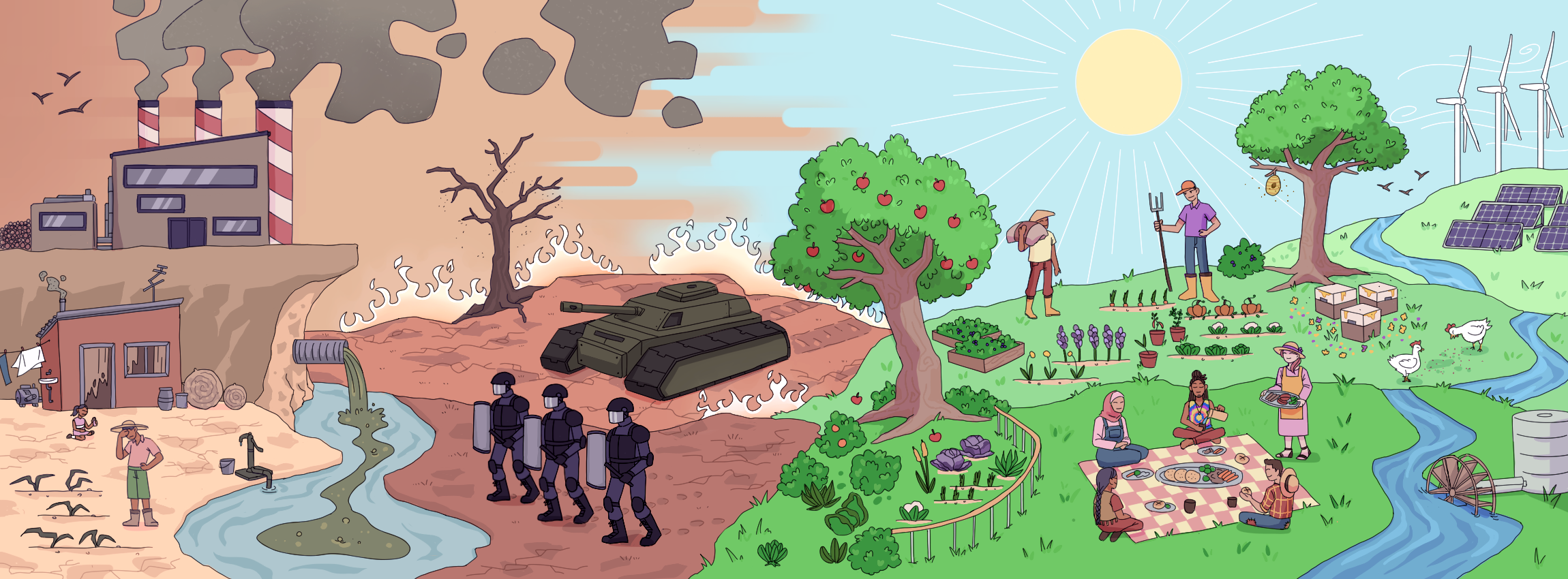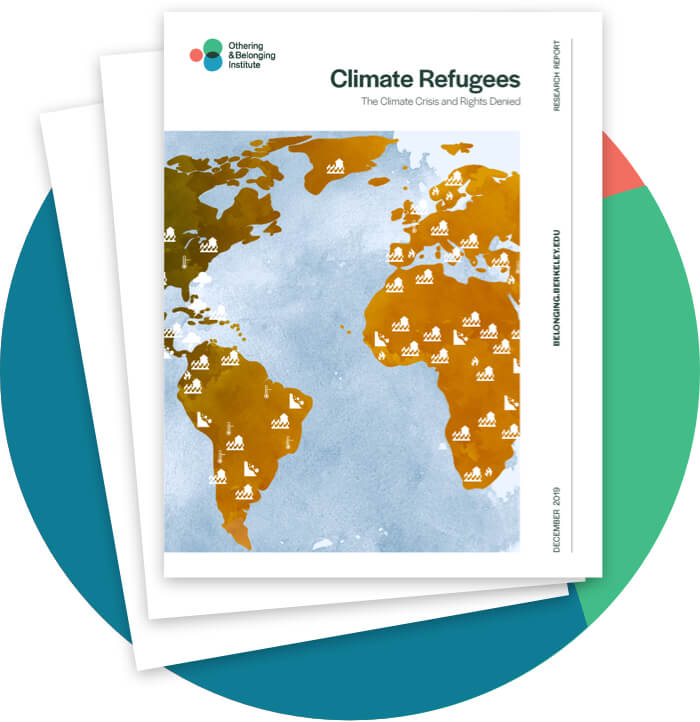Libya
Introduction to Libya
Located in North Africa's expanse along the Mediterranean coast, Libya has a population of approximately 6.9 million, with an urban population constituting 78% and rural inhabitants making up the remaining 22%.1 Libya's colonial history includes Ottoman, Italian, and briefly German occupation before gaining independence in 1951. Muammar Gaddafi came to power in 1969 and led the country until 2011, followed by a period of civil war and instability after his assassination. Libya’s political economy is largely oil-dependent, with oil revenues comprising 90% of total export earnings and 60% of the nation’s total GDP2 , with public debt estimated at $33 billion in 2021, or 83% of GDP.3 Libya is a nation dominated by arid terrain, with the Sahara Desert punctuating its landscape. Characterized by scorching summers and mild winters, Libya's climate is defined by extremes, rendering its agricultural heartlands and coastal settlements vulnerable to the impacts of climate change.4 Recent decades have witnessed a surge in extreme climate-related events, including prolonged droughts, intense heat waves, and relentless dust storms, amplifying water scarcity and soil degradation, only intensified Libya’s political and economic fragility. The combination of such events and Libya’s structural and historical circumstances render the country acutely vulnerable to the climate crisis.
Mapping Major Climate Events and Climate-Induced Displacement
Libya's vulnerability to climate change is starkly evident, with the ND-GAIN index ranking the nation low in climate-readiness, at 174th of 185 nations.5 Libya is also ranked as the sixth most water-stressed country in the world.6 Coastal regions, where a significant portion of the population resides, face escalating risks from sea-level rise and storm surges, exacerbating threats to livelihoods and infrastructure.7 The compounding impacts of climate change have precipitated a rise in internal displacement, with communities fleeing their homes in response to and in anticipation of environmental degradation and climate-induced disasters. In September of 2023, a devastating natural disaster unfolded in eastern Libya wherein Storm Daniel wreaked havoc with heavy rains and fierce winds, displacing at least 34,000 people and leaving over 10,000 unaccounted for8 , and incurring an approximated $1.8 billion USD in damages and losses.9 Nation-wide, the number of internally displaced persons in Libya due to climate-related factors has exponentially increased, from approximately 3,000 reported displacement between 2011- 2017, to 59,000 displacements between 2017-2023, caused by extreme storms and flooding10 , highlighting the urgent need for adaptive strategies and humanitarian interventions.
Mapping the Costs of the Climate Crisis
The GDP per capita of Libya is approximately $6,300 USD (2022), a figure that has significantly decreased from its 2011 value following the political upheaval of the assassination of Muammar Gaddafi. His removal was largely connected with the perceived threat to NATO super-powers posed by Gaddafi's proposed creation of an autonomous African currency, a continental army and a singular passport.11 Since then, Libya has grappled with governance challenges, including the establishment of rival administrations such as the Government of National Accord (GNA) in Tripoli and the Tobruk-based House of Representatives, leading to a fractured political landscape. Against the backdrop of political uncertainty, Libya's economy remains heavily reliant on oil production, with the sector contributing a significant share to the nation's GDP at approximately 60 percent10 , with the nation holding 39% of Africa’s total oil reserves.12 Disruptions in oil production caused by political destabilization and NATO oil and gas blockades coupled with the impacts of climate change, have engendered severe economic fragility, exemplified in 2021, wherein two years of conflict led to an oil blockade, incurring a national revenue loss of around US $11 billion. It is critical, however, to note that industries that make Libya’s economy so robust are the same industries that make it so ecologically and economically vulnerable. Rising temperatures and erratic precipitation patterns have led to agricultural losses, diminished water resources, and increased reliance on food imports, straining government finances and exacerbating food insecurity.13
The impacts of water stress remain imminent, with projections for 2040 indicate that this scarcity will worsen and the looming risk of water depletion presents a severe threat to the agricultural sector, which employs a quarter of the population in Libya's southern region.14 Projected yearly temperature rises of approximately 1.5-2°C in Libya are expected to result in a decline in crop yields of as much as 30 percent by the year 2060.14 The port city of Derna, with a population exceeding 90,000, experienced the most significant flooding from Storm Daniel in 2023, largely attributed to the deteriorating condition of the Derna and Abu Mansur dams, both of which are approximately fifty years old, reflecting the critical need for climate-infrastructure investment in the region.15 In 2010, the Libyan government allocated funds to restore these dams. A Turkish company was to complete the project, but left during the NATO-backed war, leaving it unfinished and the funds unaccounted for. In 2020, engineers recommended restoring the dams, which could no longer handle normal rainfall, but these recommendations were ignored, according to Abdel Moneim al-Arfi, a member of the Libyan Parliament.16 These conditions are only set to worsen, with rising sea levels resulting from a projected 2.6°C warming by 2100 are estimated to cost Libya an estimated $1.7 billion.17 Further, the escalation of desertification in Libya poses a significant environmental challenge, heightening the risk of further degradation of the limited arable land and potentially threatening food security, with 21.2% of the population already experiencing severe food stress.
Mapping Resilience and Mitigation Pathways
In terms of greenhouse gas emissions, Libya has the highest emissions per capita in Africa–mainly from electricity production and the oil sector— at approximately 8.5 tons of carbon per person per year.18 Yet the country was the last to develop a climate strategy (National Determined Contribution) as required by the Paris Agreement, and continues to struggle with carbon transparency. Despite this, the Libyan Environment General Authority (EGA) has collaborated with international partners to enhance its reporting capabilities. In 2020, former Prime Minister Serraj established the inaugural inter-ministerial climate change committee. Libya is also working to bolster adaptive capacities and foster sustainable development pathways. Mitigation strategies encompass investments in renewable energy infrastructure, sustainable water management practices, and ecosystem restoration initiatives such as reforestation campaigns in Al-Jabal al-Akhdar. In September 2012, the Libyan government implemented the Libya Renewable Energy Strategic Plan, which seeks a 7% renewable energy (from wind, concentrated solar power, photovoltaic and solar water heating) contribution to the electric energy mix by 2020 and 10% by 2025. In March, 2024, the United Nations Development Program launched three initiatives designed to map climate resilience in Libya, including the i.) Improved Water Security Initiative, designed to ensure long-term water security, ii.) Environment and Climate Change Mitigation Initiative, centered on efforts to reduce the flaring and venting of methane during production and refinement by Libya's hydrocarbon industry and the iii.) Support for Energy Transition Initiative, focused on transforming the country's energy system to be more equitable, resilient, and low-carbon.19 This plan, though internationally commended, has yet to report tangible progress.
Necessary Changes
As Libya navigates the intersecting challenges of political fragmentation, economic fragility, and climate vulnerability, a comprehensive approach building climate resilience is needed. A national reforestation program with international support for funding and to restore degraded land will be essential in deterring food insecurity and supporting the agricultural workforce. Developing an integrated water resources management framework is crucial, incorporating specific water-saving technologies such as drip irrigation, rainwater harvesting, and advanced water recycling systems. Rebuilding critical infrastructure, including the Wadi Derna dams, and constructing resilient housing will improve flood control and help to withstand extreme weather events. Until Libya broadens its economic base and makes strides in transitioning its energy sources, oil production will remain central to its energy infrastructure and government revenue. By promoting renewable energy and sustainable agriculture, along with national workforce training, will establish a robust non-extractive economic base. Given Libya's state of water scarcity, particularly along the coast, there is an immediate imperative to explore alternative water sources to address people's needs and offset the decline in groundwater levels. Desalination emerges as a viable solution to the water shortage predicament in Libya and other regions grappling with similar challenges.20 The wasteful and environmentally harmful practice of gas flaring contributed millions tons of carbon annually, with Libya ranked fourth globally in flaring intensity.21 Transitioning away from gas flaring and towards nationally funded initiatives for gas re-injection and conversion will be essential in mapping needed internal shifts towards global climate resilience.
Clear international changes are imperative in Libya, emphasizing the importance of self-determination and sovereignty over any external intervention in the region. Naming the detrimental role of Western intervention in Libya is of critical importance. This can be exemplified by the NATO-led military intervention in 2011, resulting in a power vacuum and fragmented governance structure that continues to destabilize the region. This instability has fueled ongoing conflict and political divisions, hindering efforts to establish a unified government. Economically, the intervention disrupted oil production and infrastructure, vital for Libya's economy, while also contributing to the proliferation of illicit arms trafficking and exploitation of natural resources by various armed groups. Ecologically, the conflict has led to damage to critical infrastructure and ecosystems, including oil spills and pollution, exacerbating environmental degradation and posing long-term risks to public health and ecological sustainability in the region. Critically examining the expansion of US AFRICOM22 and other foreign military interventions in the region underscores the need to prioritize Libyan voices and interests to foster genuine stability and progress. Through concerted action and shared responsibility, Libya and the global community can forge a path towards a more equitable and sustainable ecological future, where the principles of justice and climate equity guide transformative change.
Citations
- 1"Rural Population (% of Total Population) - Libya." World Bank Data. https://data.worldbank.org/indicator/SP.RUR.TOTL.ZS?locations=LY.
- 2"Libya Economic Monitor." World Bank, 2021. https://thedocs.worldbank.org/en/doc/3d3cd163628175d3add84db3c707eaa5-0….
- 3"Libya Economic Outlook." African Development Bank, 2023. https://www.afdb.org/en/countries/north-africa/libya/libya-economic-out….
- 4"Libya." Climate Knowledge Portal. World Bank. 2022. https://climateknowledgeportal.worldbank.org/country/libya.
- 5"Libya." Notre Dame Global Adaptation Initiative (ND-GAIN). https://gain-new.crc.nd.edu/country/libya#:~:text=The%20low%20vulnerabi….
- 6"UNICEF Libya: Water Scarcity and Climate Change Analysis WASH Enabling Environment Libya." UNICEF, 2022. https://www.unicef.org/mena/documents/unicef-libya-water-scarcity-and-c…
- 7"Libya Desk Review."International Organization for Migration. 2024. https://mena.iom.int/sites/g/files/tmzbdl686/files/documents/2024-03/li….
- 8"Libya Overview." World Bank. https://www.worldbank.org/en/country/libya/overview.
- 9"Libya's September Flood Requires $18 Bln in Recovery Funds, Report Says." Reuters, January 24, 2024. https://www.reuters.com/world/africa/libyas-september-flood-requires-18….
- 10 a b "Libya." Internal Displacement Monitoring Centre. https://www.internal-displacement.org/countries/libya/.
- 11"Why Qaddafi Had to Go: African Gold, Oil, and the Challenge of Monetary Imperialism." The Ecologist. https://theecologist.org/2016/mar/14/why-qaddafi-had-go-african-gold-oi…
- 12"Libya." U.S. Energy Information Administration. International Analysis. https://www.eia.gov/international/analysis/country/LBY.
- 13"Libya's Climate Vulnerability and Adaptation on the Periphery." Carnegie Endowment for International Peace. https://carnegieendowment.org/research/2024/06/libya-climate-vulnerabil….
- 14 a b "Climate Profile: Libya." Atlantic Council. https://www.atlanticcouncil.org/programs/middle-east-programs/rafik-har….
- 15"Failed Dams in Wadi Derna, Libya." PreventionWeb. https://www.preventionweb.net/news/failed-dams-wadi-derna-libya.
- 16"NATO Destroyed Libya in 2011; Storm Daniel Came to Sweep Up the Remains: The Thirty-Eighth Newsletter." Tricontinental: Institute for Social Research. September 21, 2023. https://thetricontinental.org/newsletterissue/libya-floods/.
- 17"Climate Change Risk Profile: Libya." USAID, 2017. https://www.climatelinks.org/sites/default/files/asset/document/2017_US….
- 18"Accelerating Climate Action in Libya." United Nations Development Programme, 2023. https://www.undp.org/libya/blog/accelerating-climate-action-libya.
- 19"UN Climate Change Fact Sheet: Libya." International Organization for Migration. 2021. https://libya.iom.int/sites/g/files/tmzbdl931/files/documents/UN%20Clim…
- 20Brika, Bashir. "Desalination and Water Treatment." Desalination Water Technology 167 (2019): 351-357. https://www.deswater.com/DWT_articles/vol_167_papers/167_2019_351.pdf.
- 21"Libya: Flaring and Venting Regulations." World Bank, 2023. https://flaringventingregulations.worldbank.org/libya.
- 22Gwatiwa, Tshepo, and Justin van der Merwe, eds. "Expanding US Military Command in Africa: Elites, Networks and Grand Strategy." 2021.


